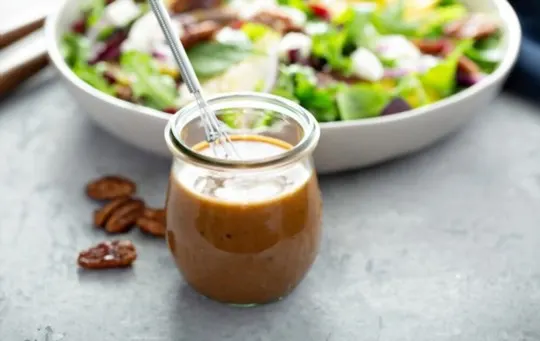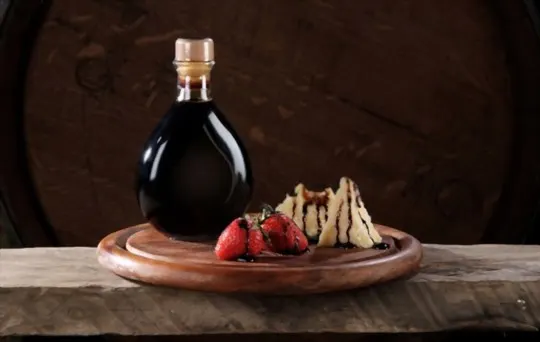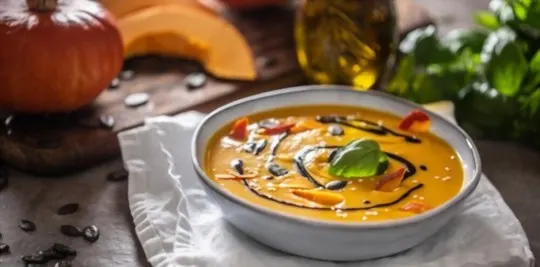Ever poured balsamic vinegar thinking it was vinaigrette? We’ve been there.
These two staples in our kitchens? Not twins. More like cousins. Balsamic vinegar is the moody pure essence, aged to perfection. Vinaigrette? That’s the lively friend, ready to dress up your salad with oil and spices. We love them both, for totally different reasons.
Their roots? Deep in culinary tradition. Yet, we often mix up their roles. One day, we’re drizzling vinegar, expecting a balanced dressing. The next, we’ve crafted a vinaigrette masterpiece, wondering why it’s not tart like vinegar.
This mix-up? It’s like mistaking sneakers for dress shoes. They both go on your feet, but the outcomes? World’s apart.
Stay tuned. We’re digging deeper, separating these cousins.

What is Balsamic Vinaigrette?

Balsamic vinaigrette is a type of salad dressing made using balsamic vinegar as the main ingredient.
This tangy and slightly sweet dressing is popular for its ability to add both flavor and depth to salads.
Unlike balsamic vinegar, which is just one ingredient, balsamic vinaigrette is a combination of several ingredients, each carefully selected to create a delicious and well-balanced taste.
Here, we will delve into the specifics of what makes balsamic vinaigrette unique.
- Balsamic Vinaigrette typically consists of olive oil and balsamic vinegar as the base ingredients.
- The addition of Dijon mustard helps bind together these two liquids to create a creamy texture.
- A pinch of salt brings out the flavors within the dressing while black pepper adds zing.
- The sweetness in Balsamic Vinaigrette comes from added sugar (often honey) enhancing its flavor profile.
- Briefly whisking all ingredients well help create an emulsion resulting in an evenly mixed Balsamic Vinaigrette.
Notably, unlike synthetically-made dressings, Balsamic Vinaigrette contains no preservatives or artificial flavors, making it a healthier option for those looking for a tasty and nutritious addition to their salads.
What is Balsamic Vinegar?

Balsamic vinegar is a type of vinegar that originates from Italy and is made from concentrated grape juice.
This grape juice is boiled down to make it thick, syrupy, and sweet.
It undergoes an ageing process for a minimum of 12 years in wooden barrels which give it a unique flavor profile.
The longer the vinegar ages, the more expensive it becomes.
When making balsamic vinegar, different quality grapes are used, such as Lambrusco or Trebbiano grapes.
Different acidities give way to different flavors achieved through adding carbon dioxide gas while processing the grapes’ juice.
Because of this process, balsamic vinegar has become widely popular in cuisines worldwide and used as salad dressings.
Differences Between Balsamic Vinaigrette and Balsamic Vinegar

Balsamic Vinaigrette and Balsamic Vinegar are often confused with each other.
Both of them share the same base ingredient, which is grape must.
The main difference between them lies in their final form and usage.
Ingredients Used
The components of Balsamic Vinaigrette and Balsamic Vinegar differ greatly.
While the former is typically made with oil, vinegar, and seasonings such as mustard and garlic, the latter is solely a vinegar made from grapes.
The composition of the two provides varying nutritional value and taste.
Preparation Process
The process of making balsamic vinaigrette involves combining balsamic vinegar with other ingredients such as olive oil, honey, mustard and herbs.
The resulting mixture is a tangy and flavorful dressing that can be used for salads, marinades or dipping sauces.
Here’s a step-by-step guide on how to make balsamic vinaigrette:
- Combine 1/4 cup of balsamic vinegar and 1 tablespoon of honey in a mixing bowl.
- Add 1/2 cup of olive oil to the mixture while whisking continuously until emulsified.
- Mix in 1 teaspoon of Dijon mustard for added flavor.
- Add some chopped herbs such as basil or thyme if desired.
- Season with salt and pepper to taste, then mix well. Refrigerate any leftover dressing in an airtight container for up to one week.
It’s important to note that balsamic vinaigrette is different from just balsamic vinegar alone.
While they have similar flavors, balsamic vinegar is just the concentrated grape juice that has been aged in wooden barrels, whereas the vinaigrette adds other ingredients for flavor and texture.
When using balsamic vinegar by itself, it can be mixed with olive oil or drizzled over roasted vegetables or grilled meat for added sweetness and acidity.
However, it may not have the same consistency or complexity as the dressing.
Flavor Profile
Balsamic vinegar has a pungent and tart flavor with notes of sweetness, while balsamic vinaigrette has a more complex flavor profile.
In addition to the tartness of the vinegar, the vinaigrette includes other ingredients that add unique flavors.
Olive oil and herbs provide earthy tones, while honey or sugar can balance out the tanginess.
The inclusion of these extra flavors sets balsamic vinaigrette apart from plain balsamic vinegar.
When used in cooking or as a dressing, balsamic vinegar adds sharpness to dishes and pairs well with sweeter ingredients like fruits and caramelized onions.
Balsamic vinaigrette is a popular salad dressing due to its versatility in enhancing both sweet and savory salads.
Its more complex flavor profile can also elevate marinades or drizzled over roasted vegetables.
It’s important to note that not all balsamic vinegars are created equal – some lower quality versions may have added sugars or thickeners that alter the taste.
However, high-quality traditional aged balsamic vinegar can be an excellent addition to any dish needing a punch of tartness.
Understanding the differences between balsamic vinegar and balsamic vinaigrette can help you choose which one will best complement your dish or salad.
While balsamic vinegar is great for adding sharpness, balsamic vinaigrette provides a full range of flavors to elevate any dish.
Uses in Culinary Applications
In culinary applications, both balsamic vinaigrette and balsamic vinegar have their distinctive uses.
Balsamic vinaigrette is commonly used as a salad dressing, marinade or dipping sauce due to its tangy flavor and creamy texture.
On the other hand, balsamic vinegar is often used in sauces, glazes and reductions to enhance the flavors of dishes with a sweet and sour depth.
Both can be easily incorporated into various recipes such as grilled meats, roasted vegetables or even desserts for added complexity and depth of flavor.
Similarities Between Balsamic Vinaigrette and Balsamic Vinegar

Balsamic vinaigrette and balsamic vinegar share a few similarities.
Both are made using grape must, which is pressured cooked grape juice, and vinegar.
The quality of the grapes determines the quality of the vinegar produced.
Additionally, both are often used as dressings in salads to add flavour and depth.
Moving forward, balsamic vinegar comes undiluted from Modena, Italy, or Reggio Emilia and is a versatile ingredient used in various dishes like Parmesan cheese and strawberries.
On the other hand, balsamic vinaigrette contains extra ingredients such as olive oil, honey or garlic for dressing purposes.
However, it’s essential to remember that not all balsamic vinegars are created equal.
It is worth noting that there are some differences between authentic balsamic vinegar and commercial brands sold in stores worldwide.
Authentic sellers age their products for over 12 years with oak barrels while giving them particular consistency and sweetness at low acidity levels.
These differences will impact the cost with traditional vinegars being much more expensive than commercially produced brands.
How to Make Balsamic Vinaigrette with Balsamic Vinegar?
To create a delicious Balsamic Vinaigrette using Balsamic Vinegar, follow these 5 simple steps:
- Combine 1/2 cup of Balsamic Vinegar and 1/4 cup of olive oil in a mixing bowl.
- Add 1 tablespoon of Dijon mustard to the mixture and whisk until fully combined.
- Gradually pour in another 1/4 cup of olive oil while continuing to whisk the ingredients together.
- Stir in a pinch of salt and pepper to taste, then adjust seasoning if necessary.
- Pour your homemade Balsamic Vinaigrette over your favorite salad or vegetables and enjoy.
It’s worth noting that high-quality balsamic vinegar, like traditional balsamic from Modena, Italy, will yield a more flavorful vinaigrette compared to lower quality options.
Conclusion
Balsamic vinaigrette and balsamic vinegar, although both made from grapes, differ in their preparation method, taste, and intended use.
While balsamic vinegar is produced through a long and complex process of aging grape must, balsamic vinaigrette includes additional ingredients like oil and herbs.
Balsamic vinegar is commonly used as a condiment or dressing in its pure form, whereas the more versatile balsamic vinaigrette can be used to dress salads or complement various dishes.
Understanding the differences between these two varieties can help individuals make informed choices about which one to select for their recipes or meals.

Leave a comment